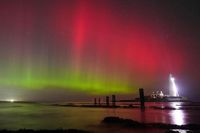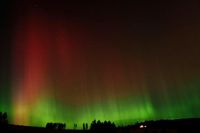Multiple states across the northern United States are poised for a spectacular view of the northern lights, also known as the aurora borealis, on Thursday night, April 17, 2025, thanks to a forecast from the National Oceanic and Atmospheric Administration (NOAA). The aurora is expected to be particularly vivid, with a Kp index of four on a scale of nine, indicating that it will move further from the poles and become brighter, making it “quite pleasing to look at,” according to NOAA.
The northern lights become visible due to geomagnetic activity, which occurs when solar winds collide with the Earth's atmosphere, resulting in stunning displays of color in the night sky. Earlier in the week, on Wednesday night into Thursday, the aurora was forecast to be visible across approximately 15 states, with a Kp index peaking at 6.33, attributed to a minor to moderate geomagnetic storm.
As for the areas expected to witness this celestial phenomenon, the northern lights will be visible in Alaska and Canada, with the viewing line extending southward to include parts of Washington, Idaho, Montana, North Dakota, South Dakota, Minnesota, Wisconsin, Michigan, and Maine. For those hoping to catch a glimpse of the aurora, NOAA suggests finding an unobstructed, north-facing vantage point away from city lights. The best time to view the lights is between 10 p.m. and 2 a.m. local time, which coincides with periods of heightened geomagnetic activity.
However, for residents in Kentucky, the outlook is not as promising. While much of the state experienced a stunning display of the northern lights during a geomagnetic storm last October, the latest forecasts indicate that the chances of seeing the aurora on April 17 are slim. The solar storm that had previously made the lights visible seems to have subsided, meaning Kentuckians will likely have to look further north to catch the aurora.
The NOAA forecast map has revealed that the southernmost locations where auroras are likely visible have shifted northward, cutting through the far northern states. This means that even if the weather conditions were ideal, the auroras would not be visible from Kentucky on this particular night. The current Kp scale stands at four, indicating visibility primarily from higher latitudes.
In Oregon, the situation is similar. As a moderate strength geomagnetic storm approaches on the night of April 17, forecasts indicate that the northern lights will likely remain out of reach for residents in Portland. The NOAA's Space Weather Prediction Center has reported that the glow of the aurora will stay well to the north, with the best chances to view the lights found in parts of Canada and northern U.S. states, including northern Washington.
Geomagnetic storms have been increasingly common in recent years, leading to more frequent sightings of the aurora borealis. For instance, one of the best views in the region occurred during an event in October 2024. However, these storms can also have more serious implications, as they can disrupt satellite communications, GPS signals, and even power grids during particularly strong events.
As the sun approaches its "solar maximum," which peaked in October 2024, scientists anticipate that the period of heightened geomagnetic activity could continue for about a year. This means that while the northern lights may not be visible everywhere at all times, there will likely be additional opportunities to see them in the future.
For those eager to capture the beauty of the aurora borealis, it's important to be prepared. If you're planning to photograph the lights, NOAA advises using night mode on your smartphone camera and lowering the shutter speed to increase the chances of capturing the movement and brilliance of the lights.
In summary, while the northern lights are expected to dazzle many across northern U.S. states on Thursday night, those in Kentucky and Oregon may need to wait for the next opportunity. With the ongoing solar activity, enthusiasts can remain hopeful for future displays of the aurora borealis in their skies.





